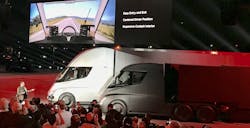One of my favorite songs over the years is Blowing in the Wind by Peter, Paul, and Mary. I thought of this line while considering the specifications given for the new Tesla Semi. Before I go further, a confession. I worked with Jerome Guillen, the manager for the Tesla Semi, when he was at Freightliner, now Daimler Trucks North America. At first he was a consultant from McKinsey helping with cost reduction. Then he became the program manager for the Freightliner Cascadia, which hit the market in 2007. I have a lot of respect for Jerome. He’s got a doctorate in physics, so he knows his stuff both technically and from a business perspective.
Like some other editors, I’ve got a few questions regarding the specifications on the new product from Tesla. I was impressed, almost to the point of disbelief, by the aerodynamic spec of a CdA of .36. In the work I’ve done, I usually see percentage improvements in aerodynamics. Few, if any, have revealed publicly their aerodynamic performance specification. I’ve worked on reviews of GHG2 regulations and thought that was way beyond realistic. But, it turns out it is much better than the results for the average production vehicle, but not beyond what has been demonstrated in concept vehicles. It is in the GHG2 rules as meeting the highest aerodynamic level of Bin VII. The images in the release show a truck with cameras instead of mirrors. Well, that’s not legal. I’m not sure our government is about to change that. Certainly, not in time for a production release in 2 years. The government cannot work that fast. I look forward to having an independent, respected group run a test. What’s missing for me, is the wind average aerodynamic performance. Winds hit a truck at all angles at the same time that they slice through the air going forward. Come to think of it, the truck is so good, it might make sense for another truck maker to buy into Tesla to use some of those trucks to help with its average for GHG2 production. But, then, why did Toyota and Daimler sell their stakes in Tesla in the last few years.
I heard Elon Musk talk about jack knifing of semi’s. I’ve been working on braking systems and advanced safety systems for many years. Most jack knifing accidents were eliminated with the advent of ABS. Further improvements in semi safety were made with those fleets that chose roll stability control, a different accident. Finally, as of August 1 of this year, all semis should have ESB (Enhanced Stability Control) with braking at each individual wheel end to avoid loss of control. I don’t see the claim for the Tesla Semi as any better than every other semi in production now. (As a side point, in Europe it’s called ESP for Enhanced Stability Pneumatics. But it acts as if it has ESP and can understand what the truck is thinking.)
Price may not be as prohibitive as some are suggesting. This vehicles saves the cost of an engine, transmission, driveline, and two axles. That’s a lot of expensive metal and electronics that are eliminated. They are replaced by expensive batteries, and 4 wheel end motors. Costs of those items are decreasing. Europes coaches and buses are moving to electric quite quickly, which should help with the wheel end motors. Batteries are decreasing in cost as well. Cost might not be as bad as you think. The claims made about no breakdown in a million miles seems a bit of an overoptimistic marketing ploy. I believe I heard some disclaimers such as regular maintenance and such. Electrical connections almost always have some issues along the way.
One more comment on the specs. What will it mean for a fully loaded tractor/trailer rig to go from 0-60 mph in just 20 seconds? You better have that load in the trailer secured exceptionally well.
Next up? The Nikola product introduction. Stay tuned. It likely will not be as electrifying.
About the Author
Paul Menig
CEO
Paul Menig is the CEO of Business Accelerants, a consulting company focused on helping companies succeed by leveraging technology in their products and processes.
